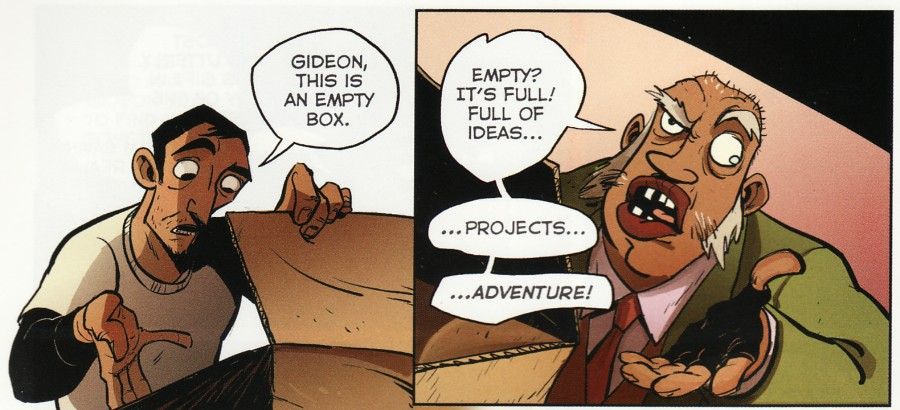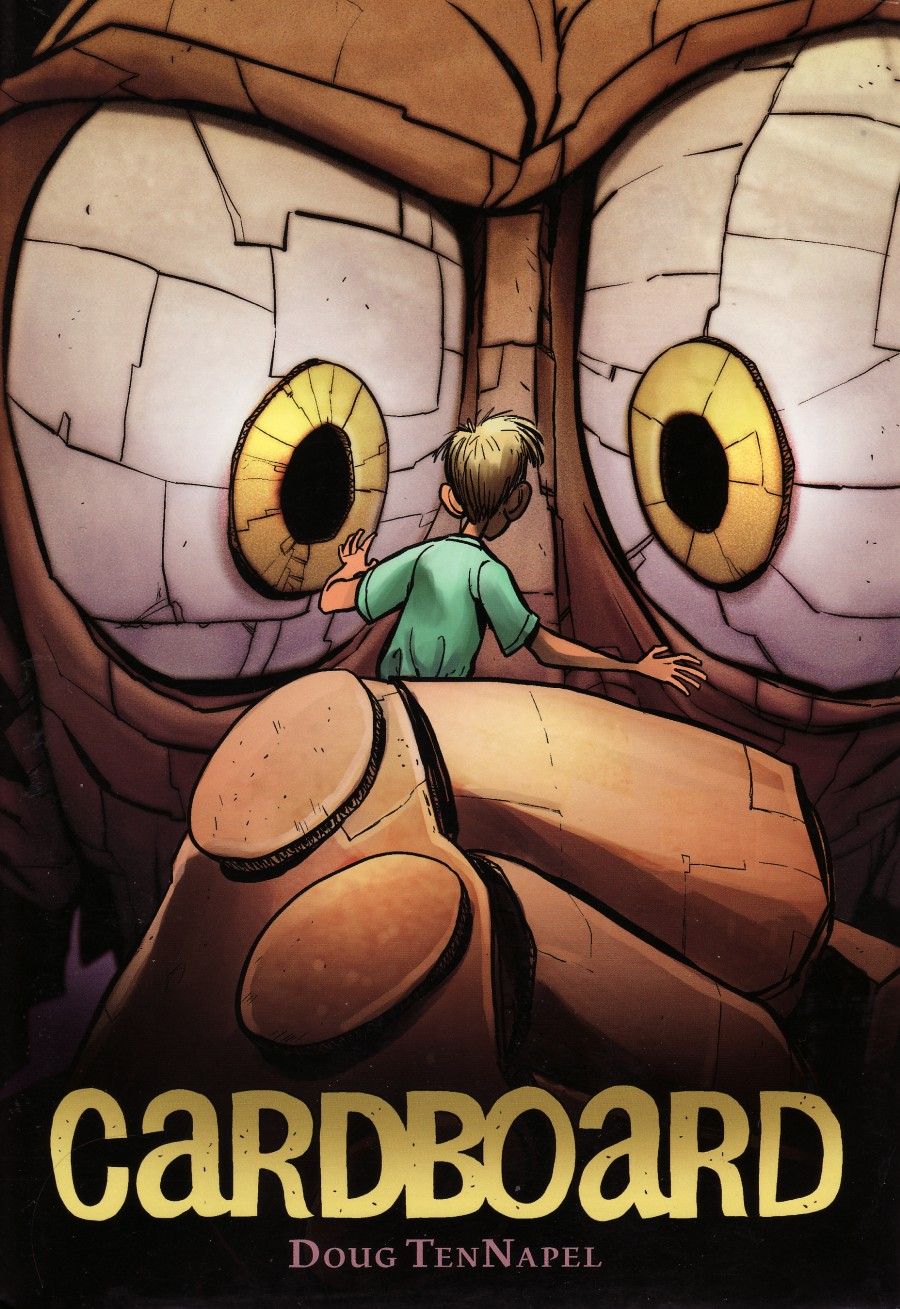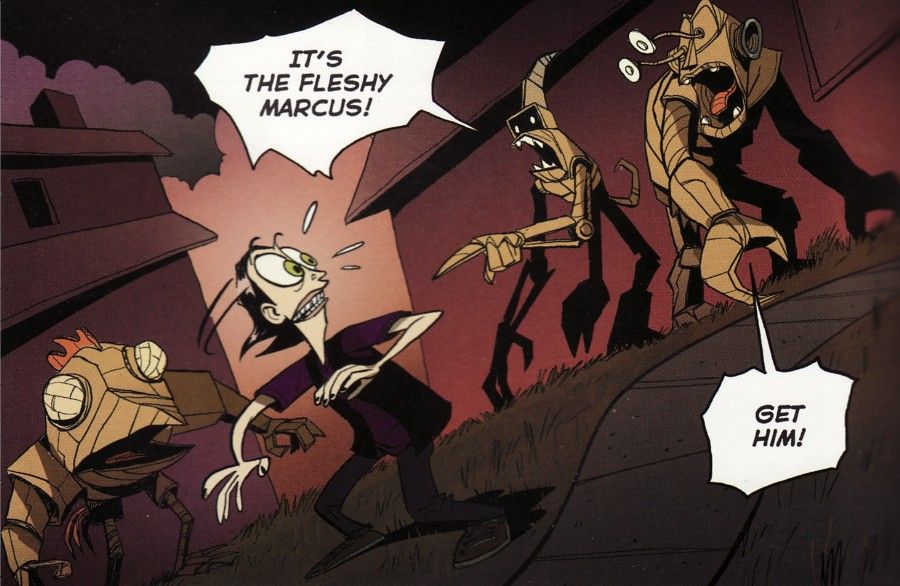I relate to the main character from Doug TenNapel’s Cardboard more than I want to. His name is Mike, he’s the father of a pre-teen boy and he’s looking for work in a crappy economy. Fortunately, I’m not a single dad and I also haven’t had to bring home a cardboard box for my son’s birthday. That’s all that Mike can afford, but the box does come with the promise of adventure. The old man on the street corner who sells it to Mike explains that it’s “actually a father-and-son project in disguise! Slay the giant! Kill the Nazis! Hunt for buried treasure!” It’s not just a box, Gideon claims, “it’s everything mankind ever needed to accomplish pressed into a cube of corrugated pulp.” It also comes with two rules.
Any time a creepy old guy sells you something from a ramshackle shop and that thing comes with rules, you know trouble is coming. The cardboard’s rules are that 1) Mike must return all the scraps when he and his son Cam finish their project, and 2) they can’t ask for any more cardboard. Naturally, they break both.
As these things will, the problem begins with a creepy butthole kid who lives next door. Marcus is a rich kid whose obnoxiousness has left him with only two friends: his rat Fang and a sunglasses-wearing boy appropriately known as Pink Eye. Marcus mocks Mike when he brings home the box, but laughter turns to jealousy once Mike and Cam have created a cardboard boxer named Bill who comes to life. Meanness ensues, scraps are not returned, thefts occur and before long Marcus is creating his own army of cardboard monsters that gets horribly out of control.
There are some recognizable tropes in the plot to Cardboard. The old man Gideon reminds me of Mr. Wing from Gremlins; Marcus has more than a little in him of Sid from Toy Story. But these are classic elements because they’re fun and TenNapel uses them well. Gideon’s rules make the story exciting as soon as he utters them because you know that something’s going to go wrong. It’s one of my favorite ways to begin a story as long as the rules aren’t arbitrary or broken for stupid reasons. They're neither in this story.
Marcus isn’t just an analog for the Toy Story bad guy either. TenNapel spends a lot of time on Marcus, letting readers see the boy’s loneliness and vulnerability when he’s by himself. Marcus avoids becoming a stereotype in other ways, too. His parents don’t neglect him nor does he bully because someone’s bullying him. He’s just a very privileged kid with some big self-esteem problems. I love how no one gets the blame for this but Marcus and how – at times – he seems desperate to change his situation. He’s locked into a pattern of behavior though, so he’s an unpredictable villain. It’s difficult to tell when he’s reaching out for connection and when he’s just being manipulative.
I haven’t mentioned Cam very much, but Cardboard isn’t really his story. It’s surprising in a book about magical cardboard that the kid who controls it isn’t also the protagonist, but that’s one of the things I like most. Cam is having a great – though scary – adventure, but he’s a good kid from beginning to end. He’s the rock that the others hold onto, and I suppose that includes young readers as well.
My son read this and two other TenNapel books (Bad Island and Ghostopolis) in a couple of sittings. His favorite character in Cardboard is Cam and it’s not hard to see why. My favorite characters are Marcus (because I love a complex, believable villain) and Mike. Not only do I relate to Mike in the ways I mentioned before, but as an adult reader, it’s easy to see that Mike is the true protagonist of the story. As he struggles through the grieving process over his wife’s death on top of how to provide for his son in a down economy, Mike has the most to learn from the events surrounding the magic (possibly; Gideon’s deliberately vague about where the stuff came from) cardboard. And though I’m not a widower trying to decide if the time is finally right to start paying attention to my pretty and kindly next-door neighbor, there’s enough truth to Mike’s conflicting emotions that I can relate to him on that, too.



